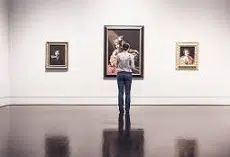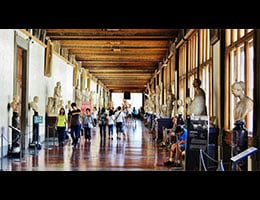 The term gallery has several uses. On this occasion we are interested in its meaning as a site intended for the exhibition and sale of artistic works . These spaces are known as art galleries .
The term gallery has several uses. On this occasion we are interested in its meaning as a site intended for the exhibition and sale of artistic works . These spaces are known as art galleries .
An art gallery, therefore, is a place where there are paintings, sculptures and other works on display and/or for sale . In many cases, an art gallery is similar to a gallery or museum .
It is possible to find different types of art galleries. Some have permanent exhibitions : throughout the year, the same collections are presented so that attendees can appreciate the various works . Others set up temporary exhibitions that are renewed periodically.
In this framework, the term gallerism is used to refer to the technique and craft of managing an art gallery. It is a work that fuses different disciplines and knowledge, since it must be carried out taking into account the social and cultural context to know what to exhibit and how, at what time of the year, in addition to determining the mode of dissemination of each event.
The Uffizi Gallery , located in Florence ( Italy ), is one of the best-known art galleries in the world . It is located in a palace built in the 16th century and welcomes millions of visitors each year, who come to see the creations of Sandro Botticelli , Leonardo da Vinci , El Greco and other great artists .
It was precisely with this company that the term gallery began to be used to designate a space dedicated to the exhibition of works of art. The Uffizi Gallery was built in the 1560s with the goal of keeping the Medici collection safe.
The National Gallery (or National Gallery ), on the other hand, is an art gallery in London , the English capital. Its inauguration took place in 1824 and its collection houses more than 2,300 works. In England the Tate Gallery also stands out.
The American art dealer Larry Gagosian is the owner of the Gagosian Gallery , a name that we can find in many parts of the world throughout its two dozen locations : from New York to Athens, passing through London and Rome, there are few excuses not to visit any of them.
 The first headquarters of the Gagosian Gallery was in Los Angeles and its inauguration took place in 1979. Six years later, Larry decided to move it to New York. The importance that this art gallery gained in its first years of activity lies in the dissemination it offered to many talented young people who at that time were not known despite having a lot to say through their works.
The first headquarters of the Gagosian Gallery was in Los Angeles and its inauguration took place in 1979. Six years later, Larry decided to move it to New York. The importance that this art gallery gained in its first years of activity lies in the dissemination it offered to many talented young people who at that time were not known despite having a lot to say through their works.
Contemporary art finds an ideal space in the Saatchi Gallery , opened in 1985 by Charles Saatchi in London. Since its inception, this art gallery offered many young artists the opportunity to make themselves known and generated an impact that was impossible to deny throughout Great Britain.
In Paris is the first headquarters of the famous Opera Gallery , opened by Gilles Dyan in 1994, which currently has a wide presence in several countries, including the United States, China, England and Italy. The creations of many important artists have passed through its rooms and corridors, such as Joan Miró, Pablo Picasso, Salvador Dalí and Ron English.
When the art gallery is focused on the marketing of the works (and not on the exhibition, like museums), it functions as a link between the artist and the buyer. A painter, for example, can exhibit in an art gallery and thus reach people who are interested in purchasing his paintings.
